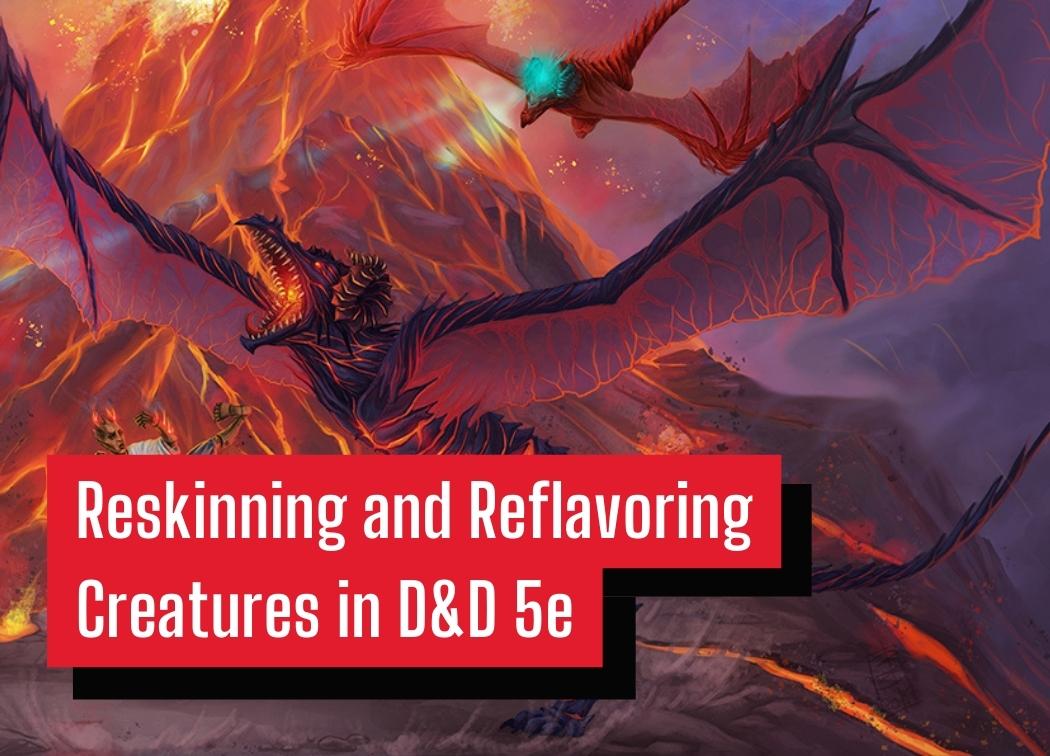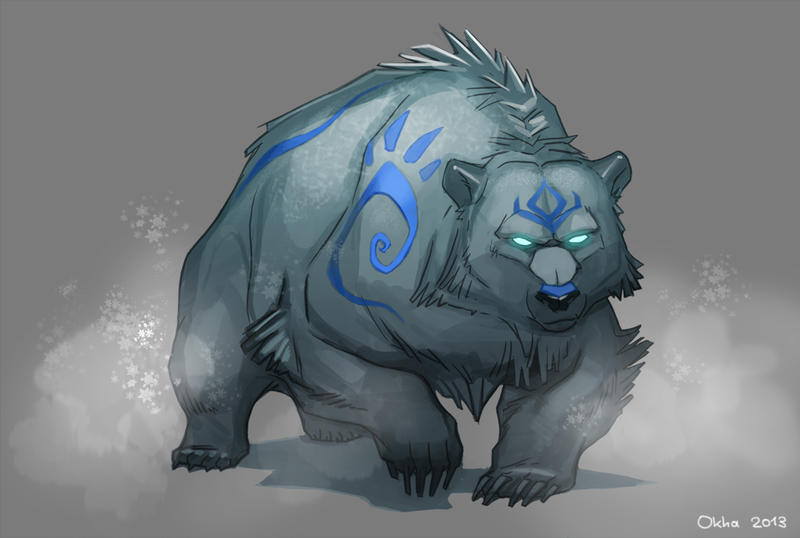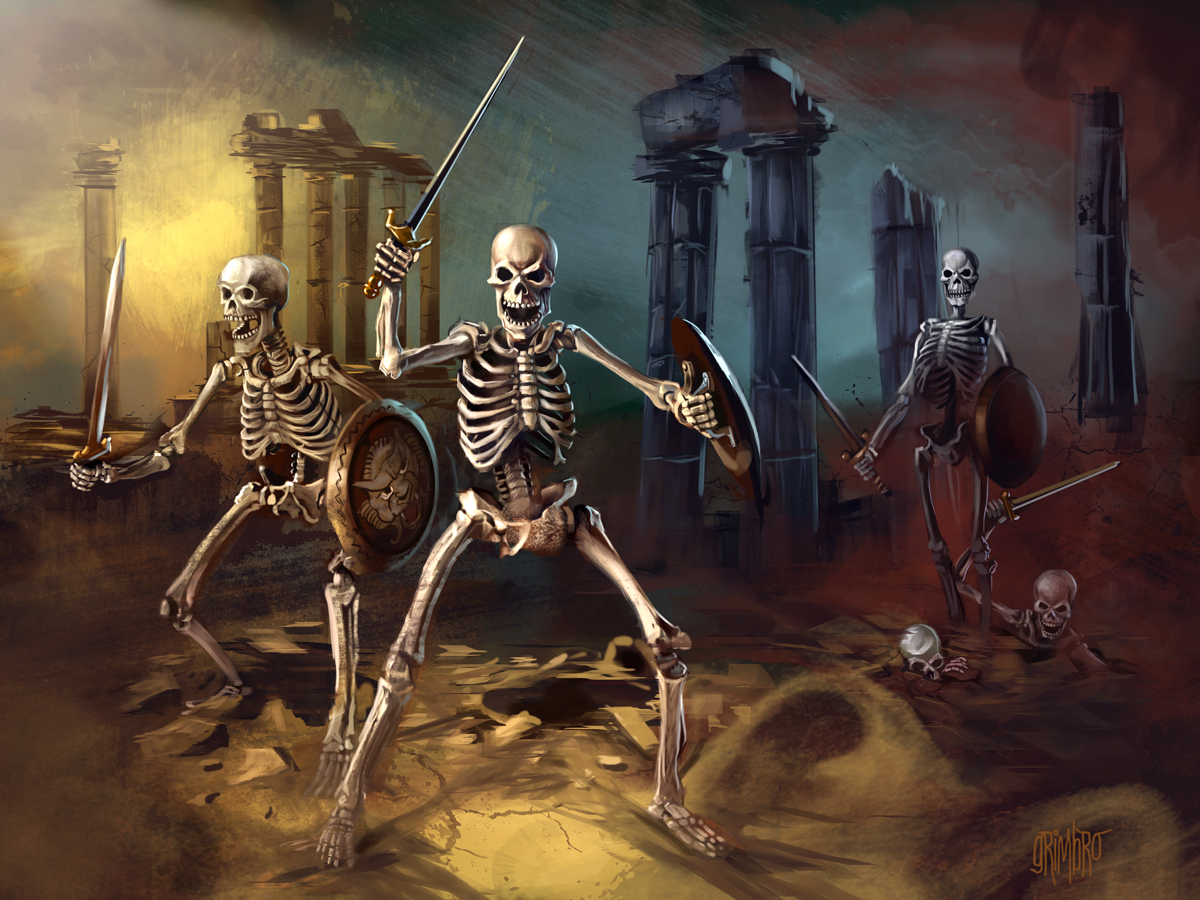Reskinning and Reflavoring Creatures in D&D 5e

My players have been around for a while and it can be difficult to make some of my favorite creatures feel new and challenging. Reflavoring and reskinning these creatures are some possible solutions to make new creatures while still keeping that classic feel of some D&D favorites.
Reflavoring and reskinning are techniques that allow a DM to make some changes to creatures, magical items, spells, classes, or anything else in D&D. These changes can be as simple as rewritten lore or a creature’s resistances and immunities. This post is going to focus primarily on how we can reskin and reflavor creatures specifically.
Reflavoring and reskinning are two techniques that are essential for DMs in homebrew campaigns. Many times the lore of the official D&D books don’t quite fit the setting or theme we are conveying in our homebrew games. Change it up a bit so that it will fit the role in the world that you intend for them to have.
Reflavoring vs. Reskinning
Reflavoring is changing the non-mechanical parts of a creature. This could be their description, history, society, behavior, or any other similar element. It’s by far the least risky option of the two when it comes down to it as nothing changes mechanically with the creature.
Reskinning is slightly different. This can involve reflavoring and typically does to some degree. However, I view reskinning as a mechanical change to a creature. For example, changing a magma bear to an ice bear by changing its resistances and damage types to cold damage.

In the end, neither of these techniques should change the creature significantly. At its core, it’s still the original creature, just with different resistances, damage types, movement options (add wings!), or any other slight change.
Reflavoring Creatures
Reflavoring creatures is something that you’ve probably unintentionally done many times now. Whenever you’ve had a creature act outside its normal personality, or had it look different from its typical appearance you’ve reflavored a creature.
Most of the time I run completely homebrewed campaigns. I create the setting and everything from scratch. I find that reflavoring is necessary for many of the creatures that I include. If I’m not using the Forgotten Realms lore then I’m going to have to change some things around. It’s just the nature of my games.
You don’t have to change every kobold in your world for it to count as a proper reflavoring. You could change a small tribe or even just a singular one and it still counts. Anomalies are a real-life phenomenon in nature and create mystery and an urge to find out what and why they came about. Use this to your advantage!
Reskinning Creatures
Reskinning a creature outright takes a bit more effort in terms of the mechanics of D&D. Changing a creature to a different type of creature, changing their resistances, or damage type can create a trickle-down effect. One change at the top can present unintended consequences later on.
This is also a great way to challenge a party if they have a lot of resistances to a certain damage type and your intended creature deals that damage type. A party full of tieflings won’t be as challenged by a fire damage type creature. Change that creature to any other damage type and the fight becomes more difficult for them.
Reskinning is a technique that even the developers use in their official materials. Take a look at any of the dragons in the MM. A green dragon is just a red dragon that’s been changed around a bit. It’s still a dragon and has all of the cornerstone abilities and stats of one, just with different damage, damage types, and abilities.
Prevent Metagaming
The monster manual is chock-full of classic D&D creatures that are considered a staple to the genre. So much so I’ve written an entire series of posts exploring some of these creatures and have barely scraped the surface! Many of these creatures are ones I’ve included in multiple games.

My players know their lore, their weaknesses, and their tactics even though their characters don’t. If you’ve fought skeletons before you know that they’re vulnerable to bludgeoning damage. Should your character intentionally not pull out your warhammer?
It’s a difficult line to tread and one that many people cross unintentionally.
Reskinning can help this type of metagaming as you can change resistances, damage types, and other parts of the statblock. The creature will still have its feel intact, but a few adjustments can turn metagaming (intentional or otherwise) on its head.
When Should You Homebrew Instead of Reskin?
The short answer is “whenever you want”. The long answer is a bit more nuanced.
There comes a point where you’ve changed enough of a creature that it’s a shell of its former self. This is where you’ve gone too far in your reskinning effort.
While anything it’s true that any part of the creature is up for grabs with reskinning you should make sure that the changes you are making are primarily thematic. Changing the damage types or adding wings to a creature is a thematic change. Changing their attacks outright and adding spells is a homebrew situation.
What you may have done in your reskinning frenzy is create a variant creature. This is a type of creature that is more powerful than its base creature. It may be able to cast spells or it has legendary actions for example. Congratulations you’ve just homebrewed a creature.
If this wasn’t your intended effect you’ll want to dial it back a bit. However, if you’re proud of what you’ve done you should keep it and consider doing more of that in the future.
Other Uses for Reskinning and Reflavoring
Believe it or not, you can reskin or reflavor any part of D&D, not just creatures. Everything is up for grabs. It’s your game, change it how it will best suit you and your group.
I tend to opt for reskinning or reflavoring instead of homebrewing player classes and subclasses. While I love creating new monsters and magical items I’m not super confident that I’ve mastered the art of creating a whole new class from the ground-up. I’m pretty focused on creating a well-balanced game so I’d hate to create something unstoppable by accident.
You can pick and choose what you want to reskin and reflavor and what you’d rather just homebrew outright. Here are some things other than creatures that are popular to reskin and reflavor.
Magical Items
Reskinning and reflavoring can give both characters and magic items some new and improved flair. Magical items are some of my favorite things to reflavor or reskin to help better-fit a character.
I particularly like the point about adding flavor to boring +1 items. Mechanically nothing changes, but having an item with a backstory can set up plot hooks, or add more depth to a character.

Generally reskinning carries very little risk from even a mechanical standpoint. Changing Flame Tongue to a warhammer will not change much unless the campaign is centered around fighting skeletons or other creatures vulnerable to bludgeoning damage.
Player Characters
Many times a player has a character idea, but it doesn’t match-up with one of the standard classes or subclasses. One solution to this is to find a homebrew option, but that can be tricky.
Another solution is to find a class or subclass that fits the idea mechanically then reskin and reflavor it as needed. This is the ideal situation for new DMs or DMs that are not comfortable with homebrew classes. The player gets what they want and the DM doesn’t have to worry about a potentially unbalanced mess.
If you are changing something that will impact the game mechanically such as spell damage types keep in mind the types of enemies that the party will face. 9 times out of 10 this won’t be an issue if a sorcerer changed all of their spells to cold damage, but if for some reason your campaign takes place on the elemental plane of fire you may just want to reflavor the character rather than change anything mechanically!
Modules and One-Shots
These are great techniques to use in pre-made adventures as well. I’ve mentioned in my review of The Fasting Worm at the Spider Feast that I love one-shots that can be easily tied into a campaign.
A bit of reflavoring or some reskinning can help you adjust the lore, setting, and theme of a module to better-suit your campaign.
Reskinning a module takes a bit more work. The idea is to change enough of the module to make it fresh, but keep the theme and feeling of the game the same.
Conclusions
While I encourage people to create their own monsters that can take a lot of effort and is sometimes more work than it’s worth. There’s no reason to reinvent the wheel when you have a perfectly good spare tire in your garage.
My players have played through a few campaigns and one-shots at this point. There’s still plenty in the MM alone that can surprise them, but sometimes you just want to use a creature that you enjoy. A few tweaks and some new flavor makes them a new, but familiar threat.
Try reskinning and reflavoring some of your favorite creatures. It’s an easy way to make the game fresh for long-time players while giving you a taste into how homebrewing your own creatures works!
